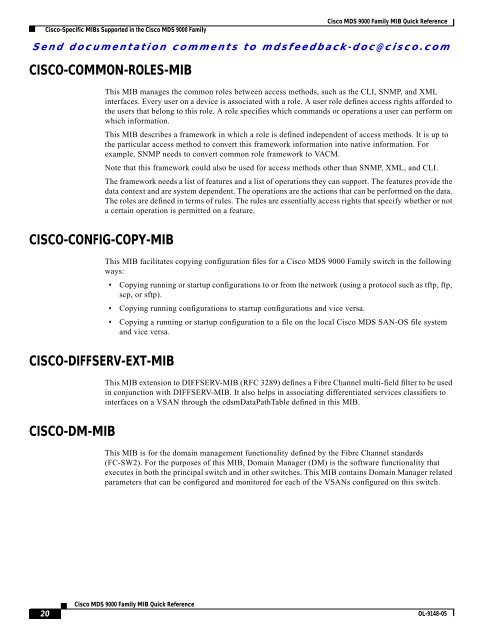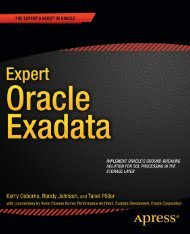Cisco MDS 9000 Family MIB Quick Reference.pdf
Cisco MDS 9000 Family MIB Quick Reference.pdf
Cisco MDS 9000 Family MIB Quick Reference.pdf
Create successful ePaper yourself
Turn your PDF publications into a flip-book with our unique Google optimized e-Paper software.
<strong>Cisco</strong>-Specific <strong>MIB</strong>s Supported in the <strong>Cisco</strong> <strong>MDS</strong> <strong>9000</strong> <strong>Family</strong><br />
<strong>Cisco</strong> <strong>MDS</strong> <strong>9000</strong> <strong>Family</strong> <strong>MIB</strong> <strong>Quick</strong> <strong>Reference</strong><br />
Send documentation comments to mdsfeedback-doc@cisco.com<br />
CISCO-COMMON-ROLES-<strong>MIB</strong><br />
This <strong>MIB</strong> manages the common roles between access methods, such as the CLI, SNMP, and XML<br />
interfaces. Every user on a device is associated with a role. A user role defines access rights afforded to<br />
the users that belong to this role. A role specifies which commands or operations a user can perform on<br />
which information.<br />
This <strong>MIB</strong> describes a framework in which a role is defined independent of access methods. It is up to<br />
the particular access method to convert this framework information into native information. For<br />
example, SNMP needs to convert common role framework to VACM.<br />
Note that this framework could also be used for access methods other than SNMP, XML, and CLI.<br />
The framework needs a list of features and a list of operations they can support. The features provide the<br />
data context and are system dependent. The operations are the actions that can be performed on the data.<br />
The roles are defined in terms of rules. The rules are essentially access rights that specify whether or not<br />
a certain operation is permitted on a feature.<br />
CISCO-CONFIG-COPY-<strong>MIB</strong><br />
This <strong>MIB</strong> facilitates copying configuration files for a <strong>Cisco</strong> <strong>MDS</strong> <strong>9000</strong> <strong>Family</strong> switch in the following<br />
ways:<br />
• Copying running or startup configurations to or from the network (using a protocol such as tftp, ftp,<br />
scp, or sftp).<br />
• Copying running configurations to startup configurations and vice versa.<br />
• Copying a running or startup configuration to a file on the local <strong>Cisco</strong> <strong>MDS</strong> SAN-OS file system<br />
and vice versa.<br />
CISCO-DIFFSERV-EXT-<strong>MIB</strong><br />
This <strong>MIB</strong> extension to DIFFSERV-<strong>MIB</strong> (RFC 3289) defines a Fibre Channel multi-field filter to be used<br />
in conjunction with DIFFSERV-<strong>MIB</strong>. It also helps in associating differentiated services classifiers to<br />
interfaces on a VSAN through the cdsmDataPathTable defined in this <strong>MIB</strong>.<br />
CISCO-DM-<strong>MIB</strong><br />
This <strong>MIB</strong> is for the domain management functionality defined by the Fibre Channel standards<br />
(FC-SW2). For the purposes of this <strong>MIB</strong>, Domain Manager (DM) is the software functionality that<br />
executes in both the principal switch and in other switches. This <strong>MIB</strong> contains Domain Manager related<br />
parameters that can be configured and monitored for each of the VSANs configured on this switch.<br />
20<br />
<strong>Cisco</strong> <strong>MDS</strong> <strong>9000</strong> <strong>Family</strong> <strong>MIB</strong> <strong>Quick</strong> <strong>Reference</strong><br />
OL-9148-05











